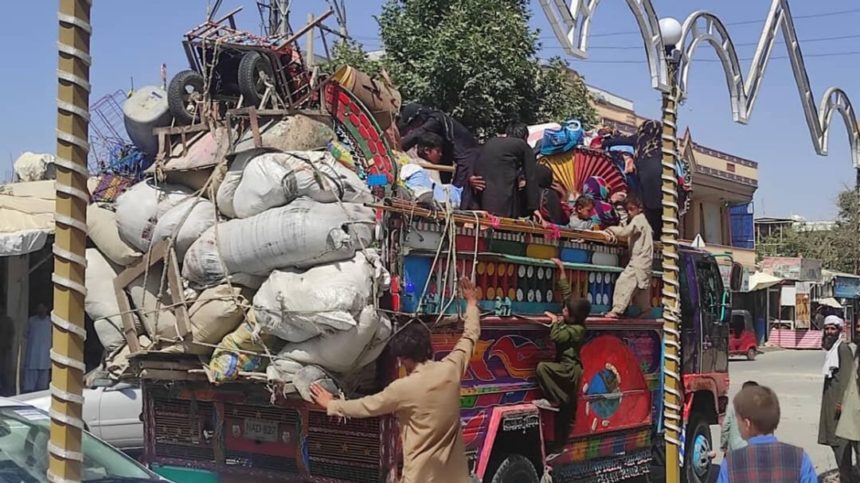RASC News Agency: The meticulously planned process of transferring three million Waziristani residents, including members of the Tehrik-i-Taliban Pakistan, to the northern provinces of the country has officially commenced simultaneously with Sirajuddin Haqqani’s visit in the month of June 2022. According to published reports, the Taliban group has distributed homes and land to forty thousand Waziristani residents so far, and this targeted process is ongoing.
The Russian news agency Sputnik, citing sources within the Taliban group, has reported that the group has distributed land to Pakistani migrants in northern Afghanistan, and Pakistan has facilitated their settlement, consumption, and agricultural expenses.
This agreement, conducted between the Taliban group and the Inter-Services Intelligence (ISI) of Pakistan, entails the transfer of Waziristani Pashtons, who are members of the Tehrik-i-Taliban Pakistan, to the northern regions of Afghanistan. They are provided with agricultural land, and Pakistan has facilitated their resettlement, provided them with seeds and tractors. Simultaneously with the confirmation of this process by Taliban officials, Mullah Hibatullah, The assumed leader the Taliban group, has supported the deal reached with the Pakistani military intelligence and has urged Pakistani Taliban to live in peace, security, and harmony in Afghanistan and refrain from using Afghanistani soil for warfare against Pakistan.
Political experts in the country and the region have regarded the coordinated efforts and collaboration between the Taliban group and Pakistan in the transfer of Waziristani Pashtons and TTP members to the northern provinces of Afghanistan as a historical and organized endeavor to alter the demographic structure of these areas and to transform the geography of terrorism in these provinces. Geopolitics of terrorism in Afghanistan has been a prominent topic in Afghan political literature, especially in past years. Over time, the insurgent groups, with systematic and deliberate approach, had played a role in the transfer of terrorists from the south to the north during the previous governments in Afghanistan. Currently, the Taliban group, by aligning the transfer process of TTP members and Waziristani Pashtons to northern Afghanistan, continues the same strategic geographical expansion for terrorism and the alteration of terrorist geography from the south to the northern provinces. This has been cited as a significant part of the major objectives of military intelligence of specific countries, especially Pakistan.
Political experts have referred to the main objective of the Taliban group in the Pashtonization project of the northern provinces of Afghanistan as the realization of the Mohammad Gul Mohmand Project, which was initiated during the treacherous reign of Afghanistan’s king Nader Shah. The Taliban intends to move approximately three million Pakistani Pashtons along the 285-kilometer route of the Qush Tepah canal and other areas of northern Afghanistan.
According to insiders, the primary goal of the Taliban group is the eradication of the population structure of this geography. Over the past two years, the group has evicted native inhabitants from several villages in the provinces of Takhar, Sar-e-Pul, and Faryab, handing them over to individuals from Pashton areas. This trend continues to persist.
The spokesperson for the Taliban group, in connection with the transfer of Pashtons from Waziristan to northern Afghanistan, had previously stated that if the Afghans on the other side of the Durand Line (the Waziristanis) pose a threat to Pakistan, they will be relocated to other provinces including northern Afghanistan.
According to informed sources, the main objective of the Pashton transfer project to the north is a complex regional and transregional intelligence project, whose primary goal is to transform northern Afghanistan into a new Waziristan, exporting terrorism and transferring terrorist groups to Middle Eastern countries, and fueling proxy wars in the region.
The project of transferring terrorist groups from the south to the north of the country began during the tenure of Minister Hanif Atmar in the government of Hamid Karzai, in coordination with Pakistan, where the transfer of terrorists from southern provinces to the north laid the foundation for this terrorist and tribal project, and it continues with the assistance of the Taliban group.
Ethnic displacement in the northern provinces of Afghanistan has deep historical roots in the tribal systems of the country. Before the Amir Abdur Rahman Khan era, it mainly affected military personnel, government officials, and a few families and tribes who were exiled to the north for criminal reasons. However, during the Amir Abdur Rahman Khan’s era, the process of voluntary transfer of Pashton tribes to the northern regions began, incentivized by financial motives. These incentives led to an eight-fold increase in the Pashton population in the north within three years.
This project was initiated during the reign of Amir Habibullah Khan, under the leadership of Mahmmood Tarzi, under the banner of “Afghani Nationalism,” but it did not have practical implications until it gained legal status with the enactment of the “Regulations for Relocating to Qataghan” in 1922.
According to Afghanistani historians, the main roots of the project to transfer southern Pashtons to the north lie in “Pashton Nationalism,” which aimed to Afghanize the heterogeneous society of the country, especially the northern provinces. This policy has transformed into the official policy of tribal governments from the past to the present.
According to political analysts, the collapse of the Zahir Shah’s regime and the occurrence of military coups, alongside America’s invasion of Afghanistan, led to the temporary suspension of the project of transferring carriers to the north. However, towards the end of Hamid Karzai’s government and until the end of Ashraf Ghani Ahmadzai’s government, the project was resumed under the leadership of Hanif Atmar in the National Security Council. Currently, the Taliban group, in collaboration with Pakistani military intelligence, is making efforts to practically implement this project.
On the other hand, Ali Reza Rajaei, an Iranian expert on Afghanistan affairs, has stated that the Pakistani Taliban’s incitement to seek refuge in Afghanistan and the weakened position of the Taliban group do not lead them to abandon their own land and seek shelter with the Taliban. Instead, they have settled in Afghanistan based on important incentives, such as land distribution and agricultural land allocation, provided by the Taliban group, as well as cash incentives offered by the Pakistani government in Afghanistan.
According to this Iranian expert, the project of transferring Waziristanis to northern Afghanistan serves as a warning to Afghanistan’s neighboring countries and has led to the eviction of other non-Pashton ethnicities from their own countries. Since the Taliban’s control over Afghanistan, this process has been taken seriously.
The public presence of forty thousand Waziristan Pashtons in northern Afghanistan this year has sparked widespread reactions from Afghanistani politicians outside the country, with some suggesting that the Taliban group is involved in this project due to their shared interests with the Waziristan Pashtons. The people of Waziristan are known for being highly traditional, religious, and conservative in social and religious matters. They have a reputation for violence, militarism, and bloody terrorist attacks. The Taliban also have a significant presence in this region, and it is said that in addition to Pakistani Taliban members, a considerable number of foreign fighters from Central Asia, the Caucasus, and Chinese Uighurs are present in northern Waziristan.
According to knowledgeable political experts, the Taliban’s inclination to transfer Waziristan terrorists to northern Afghanistan has ethnic roots within Afghanistan itself, as well as goals aimed at spreading extremism and terrorism to Central Asian countries, including Tajikistan. According to them, the Tajikistan government hosted several resistance leaders against the Taliban following the collapse of the previous Afghanistan government, and these groups are now trying to jeopardize Tajikistan’s security by transferring and strengthening terrorist groups near its borders.
On the other hand, the people of northern provinces of Afghanistan, who have been opposing the Taliban group’s activities due to their atrocities against innocent people and creating terror during the twenty-year war against the country’s security forces, have developed a strong aversion towards the group. They have forced the Taliban into retreat, and every day they expose the group’s systematic and gross human rights violations, including targeted killings.
The Taliban group Is deeply concerned about the formation of large popular circles in the frontlines of resistance against them in northern Afghanistan. They seek to prevent it with the support of the Waziristan Pashtons and suppress resistance and calls for freedom.






